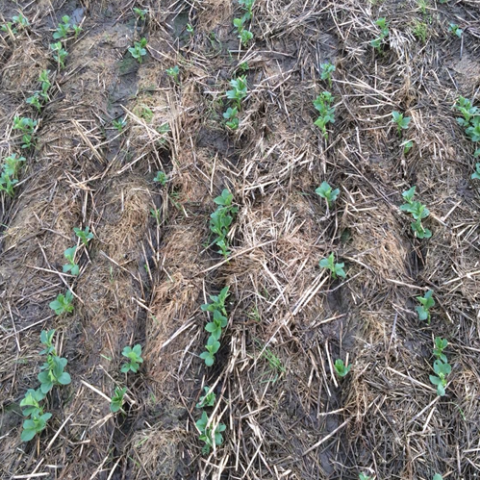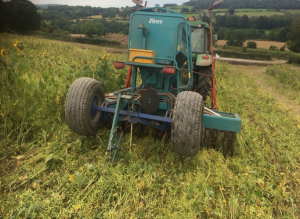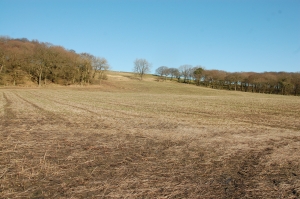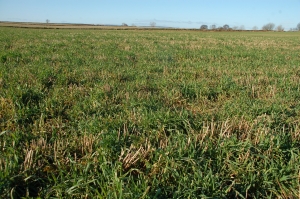Richard Suddes
The farm is based at the village of Cornsay near Consett in Co. Durham. The altitude, weather and soil type on the farm are all challenges! It is a mixed arable and beef farm with a 120-cow pedigree limousin enterprise. I manage the farm with my brother Karl (who manages the beef enterprise) and in partnership with my parents Rob and Janis. We changed the farming system 9 years ago to try to adapt more to the weather and ground conditions, and to give more focus on soil management. I look after the arable rotation and now use a direct drilling system – we haven’t ploughed since 2009.
We grow a wheat crop followed by a break crop (we try and grow as many winter crops as possible), to help with soil health and weed management. The break crops we grow are beans, oilseed rape, winter linseed and spring peas, and we are trying some lupins – as a break crop and also to feed the cattle and increase our self-sufficiency. Our yields for last year (2017) were roughly 3.5 tonnes per acre (t/ac) for wheat, 1.5 t/ac winter beans, 1.8 t/ac rape, 1.8 t/ac peas and 0.9 t/ac linseed.


Winter beans breaking through the stubble
We are constantly looking at ways to improve the soil health and are experimenting with undersowing crops with clover as well as focussing on nutrient usage and maximising the benefits of the livestock manures on the arable rotation.
Like many other dairy farming families whose stock were culled during the foot-and-mouth crisis, we chose not to return to milk production. A Limousin bull had always been used on the dairy cows and this was the breed selected for the establishment of a pedigree suckler herd in 2002. Karl travelled to France to source Limousins in their native France and came home with 60 in-calf heifers and a similar number of maiden heifers, from which he established the Cornsay foundation herd. He is now chairman of the North East Limousin Breeders Club, as well as being a member of Limousin Society’s Council of Management. Cattle performance is regarded as highly important and progress is recorded through the society’s own scheme. Herd health is also paramount and the herd is registered with the SAC premium health scheme.
Home-grown feed is used extensively and calf starter pellets are limited to calves from 3 – 5 months old, after which they move to a home-mixed grower ration, while the cows receive only silage and minerals in their straw-bedded winter accommodation. Our business now includes A Cut Above Meat Co., a recently established beef sale venture.
Wanting to move forward with the farm business, we successfully tendered for a share farming agreement on 161ha (400 acres) of arable land (8 miles away) with a local farmer. The arrangement began last April and is based on a profit-share arrangement. We use the same direct drilling and conservation agriculture techniques on this land as we have on our own. The situation of the land means that crops come on earlier than on our home farm, so it fits in with the workload and helps to spread out fixed costs. We also occasionally do some direct drilling for other people, but it has proven to be quite difficult as it is so dependent on weather and soil conditions.
Since adopting conservation agriculture techniques on the farm, we have noticed other benefits such as seeing birds in the middle of the fields rather than just round the edges. The stubbles seem to be ideal for grey partridge. We have just found out that we have been accepted for the 5 year Mid Tier Countryside Stewardship scheme – which means that we will use a wild bird seed mix on some of the poorer land – good for the birds but also for the soil as the plant roots will help improve the structure.





Sustainability in practice
Improving soil health and weed management through direct drilling, rotations and maintaining ground coverage
Direct drilling
I started direct drilling when I realised that the success of our farm depended on the health of the soil. I wanted to maintain and improve the soil, which ranges from a light, free-draining material to a heavy clay, and decided the best way to do this was by using direct drilling. It is not an easy option – you have to stick with it to get the desired results. We were forced to get rid of our plough so that we could buy a direct drill, so by default we were forced to make it work – which in hindsight was probably a good thing!
In the early days, we initially used a drill which caused too much disturbance in the soil and created a slump effect. We now work with a drill which simultaneously applies fertiliser or one which has discs for cutting through pea straw and cover crops. The secret is to drill higher seed rates early, as soon as possible after the crop is taken off. The disadvantage I have found with cover crop seed mixes is that they can contain seeds that need to be drilled at different depths – a drill with twin legs can help with this – so you can alter the seed depths.
Our soil structure is getting better and as a result will become increasingly resilient, especially after prolonged periods of heavy rainfall. The benefits of direct drilling on the lighter land became evident fairly rapidly but the heavier land is taking longer to adjust. In the recent cold weather we have experienced quite a lot of snow and noticed that it cleared from our fields way before it did on our neighbour’s fields. Establishment costs have reduced since the new system was adopted – when drilling with the Seed Hawk drill, we use 2 litres of diesel an acre.
Winter wheat field with stubble from the previous crop – earthworms will help shred & decompose the plant residues, converting them to organic matter, and releasing mineral nutrients
The varieties of winter wheat we grow are the old ones (Riband and Claire) – we’ve found that they are better for scavenging for nitrogen, are better rooting, suit the soil and climate and respond well to being drilled (we drill at a seed rate of 350 per m2, up to 500 for late drilled). We use saved seed as much as possible and no treated seed, as we don’t want to kill the mycorrhizae and it also speeds crop emergence.
Rotations
I have been working towards a rotation containing only first wheats. The original rotation was traditional with barley, oilseed rape and two wheats. This was not effective at controlling giant brome, which was getting out of hand in the barley, the fields were full of brome and volunteer wheat. We now have wheat followed by a break crop. Our current rotation is aimed at controlling weeds – the main aim is to reduce herbicide usage. Grass is not included in the rotation, but cover crops have played a role since 2013.
Wheat is our only crop with a definite herbicide programme. The break crops occasionally get herbicide to take the brome out. We are cutting down on fungicide and in 9 years we have only used insecticide twice – in 2012 when we had a leather jacket infestation in the spring barley, and about 4 years ago when we were forced to spray for flea beetle in the oilseed rape.
We are looking at trialling using compost tea as a fungicide and we have moved away from using solid potash to foliar, and want to also trial foliar N application.
Ground coverage
We rob the top land on the farm for cereal straw and apply the chopped straw to the poorer land (with glacial till), along with 90% of the cattle muck to protect the soil against downpours and increase organic matter, improve the soil structure and feed the worms. When chopping the straw, it is important to not let it get wet or stagnant to aid slugs. Try lifting the combine head up if it’s going to be a problem.
We found that the poorer soil was high in magnesium after having had (very expensive!) soil tests done – which we have attempted to combat by applying gypsum, and have since noticed increased water infiltration rates – in the past, as soon as it rained, the ground would seal up. We have found the gypsum helps to open up the soil, lets water and worms through and also increases the emergence of crops.
Evidence of earthworms doing their job – note the circular mounds
The soil structure has also improved massively – our spray runs on row crop wheels all year round. Water can infiltrate in to the soil, it has air in it and maintains structure – even on the tram lines you can still see the earthworm casts. I believe combining in every direction rather than following the same tracks spreads the impact out over the field and the soil recovers.
We use cover crops to improve soil tilth and drainage, contribute nitrogen and help control weeds. We typically grow rye, phacelia and subterranean clover as a winter cover crop, and sunflowers, peas, beans and rye during the spring, in the fields with poorer soil.
Phacelia amongst rye and subterranean clover
We only have a short weather window in autumn, with the combine coming out of the field and the drill going in almost immediately, so the advantages of cover crops are limited at that time of year. We tend to sow them on fields which need attention to improve the soil or on wet areas of fields; they work better for us when drilled in spring. We grow beans in the glacial till fields to help improve soil structure as much as possible – 35 per m2. They are grown as our winter cover crop – we know we won’t get a top yield due to high seed rates, but they’re doing a good job and we’re going to get money out of them. They can be sown later into wet conditions and grow well through winter – they are now a permanent part of our rotation.
Winter beans help to break up the soil on the poorer land – still evidence of plenty of earthworms
Motivations
My route into conservation agriculture really started through buying a strip drill and being focused on looking after the soil. I joined BASE UK and things really developed from there – I met a guy called Steve Townsend (soil advisor) in 2011, did 99% of what he suggested and it worked! And have really expanded from there.
For me, looking after your soil is number one priority. I want to reduce usage of nitrogen fertiliser (which I see as in essence poisoning the soil), and I want to increase the mycorrhizae in the soil. I want to grow cover crops that act as fertilisers, smother weeds, and allow mycorrhizae to attach. I also want to be as efficient as possible – we are aiming to be self-sufficient in every aspect of the farm. We also aim to have a closed system as much as possible – which definitely helps with our weed management – we have our own baler for example.
I was honoured to be given the accolade of UK Soil farmer of the year 2017 – an award organised by the Farm Carbon Cutting Toolkit and Innovation for Agriculture, which aims to reward farmers who manage their soils in a way which supports productive agriculture, reduces greenhouse gas emissions, and builds soil health, organic matter and carbon.
Sustainable farming is more important to us than ever with Brexit looming. Lack of funds means we have to focus on cutting back on inputs wherever possible, maintaining and increasing yields whilst dramatically decreasing inputs.
With the share farming agreement, the amount of hours we work have increased, but we would not rule out taking on more land, if the right opportunity came up. Until then, we will persevere with the direct drilling, as it is really starting to pay off.
I have recently joined an Innovative Farmers field lab – ‘In-field variation within no-till systems’ – this has just been recently formed and is looking at different farmer’s approaches to no-till; common methods and variation between them, and the group are interested in investigating the contribution of a range of substrates (such as gypsum) to soil conditions.
|
FARMER TIPS
|
Created Feburary 2018
